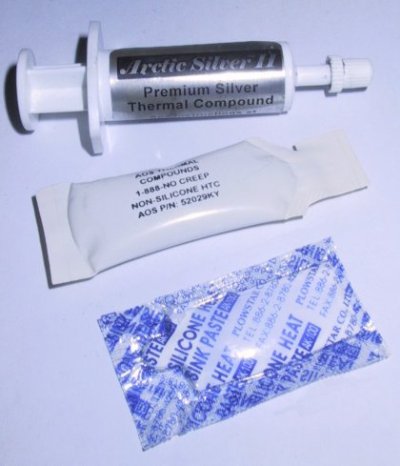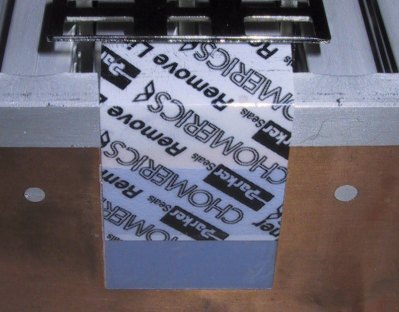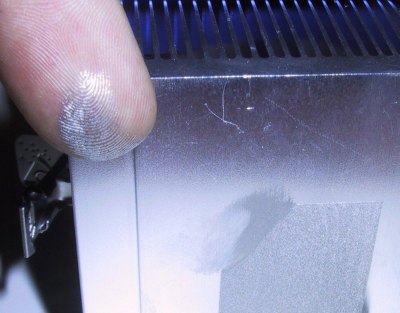THE HEATSINK GUIDE: Info about thermal compound
Why an interface material between the CPU and the heatsink?
The surface of a CPU or a heatsink is
never entirely flat; if you place a heatsink directly on a CPU, there will
be tiny (invisible) gaps between the two. Since air conducts heat poorly,
these gaps have a very negative effect on the heat transfer. Therefore,
an interface material with a high thermal conductivity is needed to fill
these gaps, and thus improve heat conductivity between CPU and heatsink.
Years ago, when CPU hat power dissipations around 10 watts, a thermal
interface material was optional, and most often used by overclockers to improve
cooling performance. With todays CPUs, it is an absolute requirement.
Popular thermal interface materials

Different thermal compounds
ArcticSilver II, AOS "HTC" Compound, standard silicone compound
The most commonly used interface material
in the electronics cooling area is thermal compound, a sticky paste applied
directly on the heatsink or CPU. A good-quality thermal compound will provide
the best possible performance. However, the disadvantage of thermal compound
is that it is quite messy to handle, and therefore not suitable for mass
production.
For this reason, most heatsink manufacturers ship their heatsinks with a "thermal
pad", which is supposed to replace thermal compound. The cheapest heatsinks usually come
with silver/grey graphite pads. Graphite pads are inexpensive, but provide poor
performance (unless a high pressure is applied to the pad, which is not the case when the CPU
and heatsink are installed in a regular way). A graphite pad is better
than no interface material at all, but if you have the choice, stay away from them.
Today, there are far more advanced thermal
pads available, made by companies such as Power Devices, Bergquist or Chomerics,
to name only a few. For links to the web sites of these companies, check
out the links page. The performance of these pads can be roughly equal to standard thermal compound.

Chomerics pad, with its protective foil
The foil must be removed before installation
Newer thermal pads are usually made of a phase-change material, which melts to fill all the fine gaps
between CPU and heatsink the first time the CPU is heated up. These pads are typically only suitable for one-time installation;
if you uninstall the heatsink, e.g. in case of a CPU upgrade, the pad must be removed from the heatsink
and replaced by thermal compound. In no case, a thermal pad and thermal compound should be used together.

A heatsink with preapplied thermal compound
Some heatsink manufacturers ship their coolers with a thin layer of preapplied thermal compound, protected by
a plastic cap. This is good, since it combines the ease of handling of a thermal pad with the good performance
of thermal compound. Here too, compound must be reapplied once the heatsink was uninstalled and reinstalled.
If installation time is not an issue, and you are looking to optimize the performance
of your cooling system (e.g. for overclocking), the best bet is to purchase a high-quality thermal compound from a
specialized retailer.
Other interface materials
Self-glueing thermal tape is very convenient for fixing small heatsinks (e.g. for memory chips), but in terms of thermal
transfer, it is not as good as thermal compound. Thermal epoxy is a two-component glue with added substances to
improve thermal conductivity. It can also be very convenient for mounting heatsinks; performance is typically
better than with self-glueing thermal tape, but not as good as thermal compound.
How should thermal compound be applied?
You should apply a very thin (paper thin)
layer on the heatsink with your finger before installing it. Don't
use too much - the thinner the layer, the better. But make sure that the entire contact area between
CPU and heatsink is covered; otherwise hot-spots can form.
Then press the heatsink firmly on the CPU. Thermal compound is a very nasty substance, it is sticky
and kind of hard to clean off your fingers. It does not conduct electricity,
so don't panic if you spill small amounts of it on the CPU's pins. Even silver-based
thermal compound has low electrical conductivity, and will not cause short circuits when spilled in small amounts.
Thermal compound normally does not get hard, it will stay sticky for years. But depending on the solvents used
in the making of the compound, it may dry over the years. This is not a reason to worry; it will still do its job
when dry, and there is no reason to replace dried thermal compound.
What does it consist
of? Is it poisonous?
Most standard thermal compound consists of silicone. However, silicone doesn't have a
high thermal conductivity, so they also contains zinc oxide to improve this. The zinc oxide
also explains its white colour.
High-End thermal compounds are usually
silicone-free, and use metal-based additives (e.g. aluminum oxide or nitride, or even pulverized silver!) instead
of Zinc Oxide.
I have heard people saying that heat sink
compound contained heavy metals and was poisonous. Neither silicone nor
zinc oxide are poisonous However, especially with advanced thermal compounds,
other ingredients may have been used, and are usually not declared. But despite
strict laws on marking poisonous substances in Europe and the US, I have never seen
a thermal compound that was marked as poisonous. Still, use common sense, and don't confuse
it with tooth paste.
Where to buy it?
Standard (silicone based) compound can be bought at almost any electronics store, including Radio Shack
(Cat. No.: 276-1372). The price is in the $2 range. Two grammes should
suffice for installing many many heatsinks. High end thermal compounds,
with even better thermal conductivities, are available from specialized
heatsink retailers; see the "Links" section for details. In the overclocking scene,
the ArcticSilver thermal compound is very popular;
it is expensive, but provides excellent performance.
Performance of thermal compound
The performance of thermal compound is measured in W/mK. Standard silicon/zinc oxide thermal compound
has thermal conductivities between 0.7 and 0.9 W/mK, high end compound
can have thermal conductivities of around 2 - 3 W/mK or more.
But not only the thermal conductivity matters. The compound should also be very smooth - if it is too grainy
or too hard, then it is hard to apply a really thin layer.
Why does my CPU get hotter after
I used thermal compound?
It doesn't - in no case your CPU get hotter
after you applied thermal compound. However, you might think that
it gets hotter, because the heatsink gets hotter. A hotter heatsink means
better thermal conductivity between the CPU and the heatsink. The CPU itself
will be cooler.
Also know as?
"heat sink jelly", "heatsink compound", "thermal compound", "thermal goo", "silicon compound".
A more scientific approach to thermal compound...
If the information here did not go enough into detail for your needs, visit http://www.electronics-cooling.com/Resources/EC_Articles/SEP96/sep96_01.htm. You'll find more scientific information about thermal compound
and related topics.
All pages copyright © 1997-2010 Tillmann Steinbrecher
Legal information / Disclaimer / Impressum



